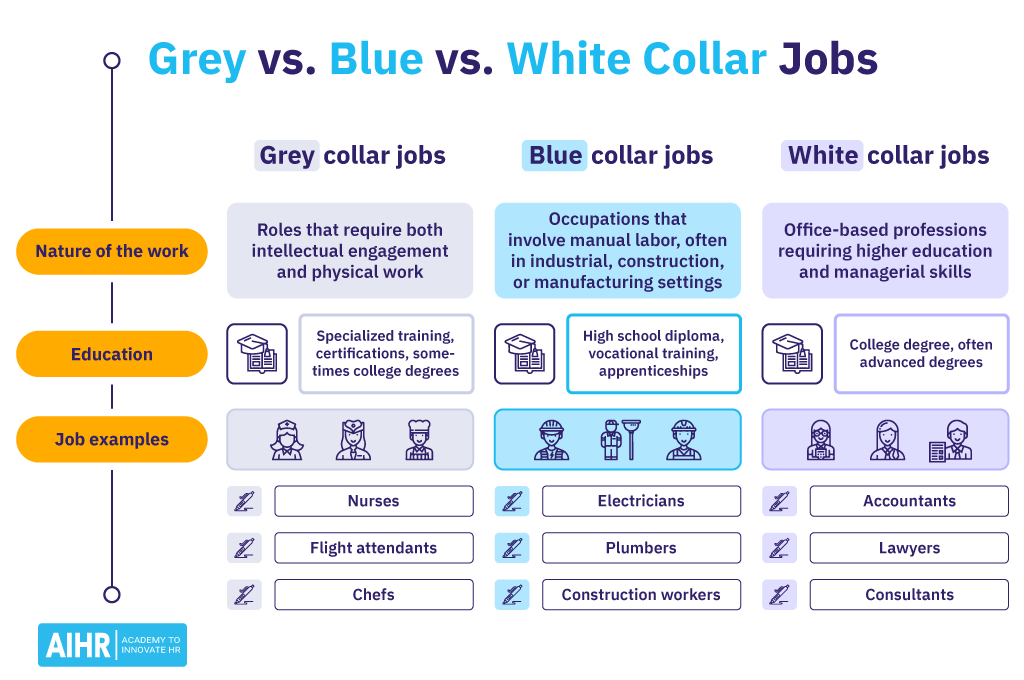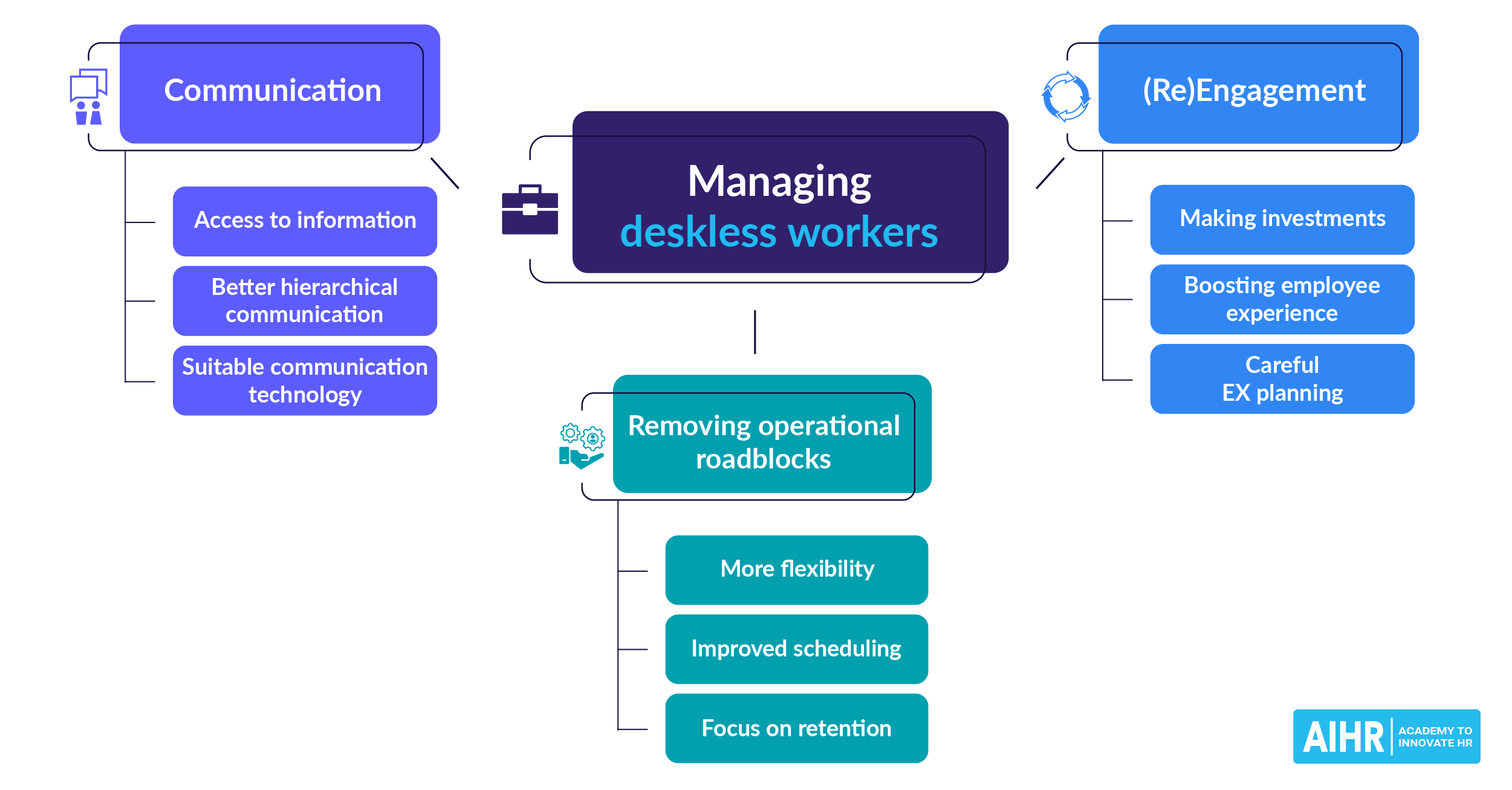Grey Collar Jobs
What are grey collar jobs?
Grey collar jobs are a category of employment that blurs the lines between white collar (professional, managerial, or administrative work) and blue collar (manual labor, skilled trades, or service industry work).
In the past, the workforce has been categorized into “blue collar” and “white collar” work. Blue collar work is generally hands-on and labor-intensive, often requiring significant physical exertion. In contrast, white collar work encompasses a variety of office jobs where formal attire, such as a dress shirt, is suitable. Here, the tasks are predominantly intellectual, with minimal physical demand.
Grey collar jobs often blend elements of both, requiring a combination of physical work, technical skill, and some level of formal education. The term “grey collar” reflects the ambiguity and diversity of these roles, which do not fit neatly into the conventional job categories. Examples of such jobs include flight attendants, healthcare professionals, and lab technicians.
According to the United States Bureau of Labor Statistics, occupations classified as grey collar are experiencing the most rapid growth. These roles are highlighted for their significant projected employment percentage increase from 2022 to 2032, leading the list of expanding job categories.
Factors influencing the rise of grey collar workers
The emergence and expansion of grey collar jobs can be attributed to multiple factors, including:
- Technological advancements: The rapid evolution of technology has created jobs requiring both technical knowledge and practical skills. Automation, artificial intelligence, and digital platforms have driven demand for workers who can navigate between manual tasks and technological innovations.
- Educational trends: There’s an increasing emphasis on vocational training and certifications over traditional educational degrees for certain professions. This has led to the growth of jobs that require specific skills and knowledge, but not necessarily a bachelor’s degree.
- Degree devaluation: The requirement for a college degree to perform high-intelligence, technology-driven jobs is decreasing. Between astronomical tuition fees and an increasing focus on skills over schooling in the workforce, those without college degrees are stepping into technical roles with skills they learn on the job.
- Economic shifts: Global economic trends, including the move towards service-oriented economies and the decline of traditional manufacturing, have reshaped the job market, giving rise to new types of employment opportunities that blend various skill sets.
Grey, blue, and white collar jobs: The differences
While the concepts of blue and white collar jobs might sound familiar, the term “grey collar” might not be as widely recognized. Here’s an overview of the key differences between grey, blue, and white collar jobs:

Let’s break it down in more detail.
Nature of the work
Often involves intellectual engagement and physical work
Manual labor or skilled trades
Primarily intellectual or knowledge-based tasks
Work environment
Varied, can include outdoors, healthcare settings, or technical fields
Factories, construction sites
Offices, corporate settings
Educational requirements
Specialized training or certifications; some jobs may require college degrees
High school diploma, vocational training, or apprenticeships
College degree, often advanced degrees
Work schedule
Can be shift-based, regular, or irregular, depending on the field
Often includes shift work, may require overtime
Typically, regular office hours. May include overtime or flexible schedules
Job examples
Healthcare professionals (e.g, nurses), flight attendants, chefs
Electricians, mechanics, plumbers
Accountants, lawyers, consultants
Examples of grey collar jobs
Several professions exemplify the grey collar category, including, but not limited to:
- Airline pilots and flight attendants who rely heavily on technology and require specialized training, while their roles also demand a significant amount of hands-on, practical work.
- Chefs and culinary professionals who have specialized training in food preparation and often work in physically demanding environments like kitchens.
- Education and childcare workers, such as preschool teachers and daycare providers. These jobs often require certifications and involve both care and educational responsibilities.
- Environmental and conservation workers who might work in field settings collecting data and managing conservation efforts, blending scientific knowledge with physical work.
- Healthcare professionals, such as nurses, medical technicians, and paramedics. These roles require specialized training and often involve both physical work and technical knowledge.
- IT network administrators who maintain and troubleshoot network systems, combining technical expertise with hands-on management of hardware and software.
- Lab technicians who bridge the gap between scientific innovation and practical application, combining technical knowledge with the hands-on skills necessary to conduct experiments and manage laboratory equipment.

Advantages and challenges of grey collar jobs
Grey collar jobs present a unique set of advantages and challenges. Here’s a breakdown:
Advantages
- Versatility: Grey collar workers often possess a mix of skills, allowing them to perform a variety of tasks. This versatility can make them valuable employees and provide job security.
- Practical application: Many grey collar jobs involve applying technical knowledge in practical, real-world situations, which can be more fulfilling for individuals who prefer hands-on work.
- Demand: As industries like healthcare, IT, and skilled trades continue to grow, the demand for grey collar workers often increases, leading to more job opportunities.
Challenges
- Educational requirements: Grey collar jobs may require specialized training and certifications, which can be a barrier for individuals without access to education or vocational programs.
- Work-life balance: Some of these jobs, especially in healthcare or emergency services, might involve irregular hours, long shifts, or on-call duties, impacting work-life balance.
- Physical demands: Even though these jobs blend elements of office work, they can still be physically demanding, which may lead to fatigue or long-term health issues if proper ergonomics and safety measures aren’t followed.
HR best practices for attracting and retaining grey collar workers
To effectively attract and retain grey collar workers, HR departments can adopt several strategic practices:
- Make the jobs attractive: Develop job postings that clearly outline the unique blend of skills and experiences needed, emphasizing the opportunities for hands-on work, problem-solving, and the utilization of technology.
Highlighting the dynamic nature of grey collar roles can attract candidates looking for engaging and varied work. - Offer market-competitive salaries: Given the specialized skill set that these employees bring, it’s essential to offer competitive salaries within the industry, recognizing their unique combination of manual and technical abilities.
- Provide continued learning opportunities: Grey collar jobs often involve rapidly evolving technologies and methodologies. Offering continuous training and development opportunities can help keep these workers at the forefront of their fields, enhancing job satisfaction and retention.
- Create a supportive work environment: Cultivate a company culture that values their unique contributions, promoting teamwork and collaboration across different job functions. Recognizing these workers’ critical role in bridging the gap between manual and intellectual labor can help integrate them more fully into the organizational fabric.
- Enhance flexibility and work-life balance: Given the diverse responsibilities and interests of grey collar workers, offering flexible working arrangements can significantly attract and retain them. Consider options for telecommuting, flexible hours, and part-time positions.
FAQ
Grey-collar jobs refer to employment that falls between blue-collar and white-collar categories. These jobs often involve a mix of manual labor and specialized skills, typically requiring some level of technical training or education. Examples include healthcare professionals such as nurses, chefs and culinary professionals, or lab technicians. They are characterized by both manual and intellectual tasks.
Blue-collar jobs typically involve manual labor and are often associated with manufacturing, construction, and maintenance industries, requiring specific trade skills. Grey-collar jobs, on the other hand, combine manual labor with specialized technical skills and training, often involving both physical and intellectual tasks.









